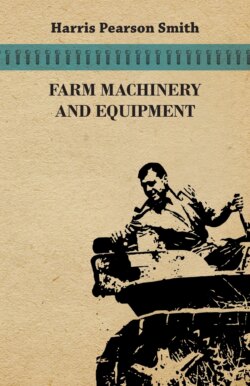Читать книгу Farm Machinery and Equipment - Harris Pearson Smith - Страница 20
На сайте Литреса книга снята с продажи.
TYPES OF CLUTCHES
ОглавлениеA clutch is a gripping device between a power source and a machine, or between working the parts in a machine, whereby the units can be connected or disconnected. In the operation of farm power equipment, clutches permit the starting of the engine with the machine disconnected. The clutch is then engaged and the power transmitted to the machine by means of shafts, gears, belts, and other devices.
Clutches are either friction or positive types. Friction clutches are used in tractors, trucks, and other equipment such as self-propelled combines and cotton harvesters in which power must be applied gradually to the load (Fig. 4–22). This type of clutch usually has flat plates covered with friction material which are held against each other by springs so that they turn as a unit, thus transmitting power.
FIG. 4–22. Friction clutch.
FIG. 4–23. Safety snap clutch.
Slip or snap safety clutches are a type of friction clutch. The two notched plates are pressed together by springs of sufficient force to transmit power for normal working loads. Should an overload occur, the clutch will slip with a snapping action and prevent damage to the working unit (Fig. 4–23). This type of safety clutch is used on many power-operated machines, such as corn pickers, forage harvesters, and haying machinery.
Positive clutches consist of two parts which have jaws so shaped and placed that when they are brought together they engage positively as a unit with no slippage (Fig. 4–24). These clutches should be engaged before applying power to the driving side. They are used when light loads are transmitted at slow speeds, as in drives for planters and grain drills.
FIG. 4–24. Positive-type clutch: A, clutch parts disengaged; B, clutch parts engaged to transmit power.
The ratchet-and-pawl arrangement, as found in the hubs of horse-drawn mowing machines and in the drives of manure-spreader aprons (Fig. 4–25), is a type of clutch. The ratchet is composed of gearlike teeth. These teeth generally have an equal slope from the vertex of the teeth on each side, or they may take a form similar to circular-saw teeth. The pawls, or dogs, consist of small pieces of cast iron that fit into recesses in a casting rigidly fastened to the axle. The outer ends of the pawls are held against the ratchet teeth by small coil expansion springs. As the machine moves forward, the three or four pawls engage the ratchet teeth and the axle turns with the wheel. A movement backward allows the pawls to slip over the teeth with a distinct clicking noise. Therefore, this type clutch operates in only one direction.
FIG. 4–25. Ratchet-and-pawl drive for manure-spreader apron. Note the eccentric drive for moving the pawl forward and backward.
The overriding clutch is a type of ratchet-and-pawl arrangement (Fig. 4–26). In some types, balls placed in tapered recesses take the place of the rectangular metal pawl. The overriding-type clutch is often used to operate fans on cotton-picking machines and forage harvesters. When the power is disengaged, the fan keeps turning to clear out any material that may be in the pipes, until it finally comes to a stop from the lack of power.
Another type is the belt-tension clutch. When an idler on a belt is mounted so it can be moved to release the tension around the pulleys, there is not enough friction on either the drive pulley or the driven pulley to transmit power. Thus, the tension applied by the movement of the idler pulley can be made to serve as a clutch to engage and disengage the power.
FIG. 4–26. Overriding- or overrunning-type clutch. (John Deere.)
